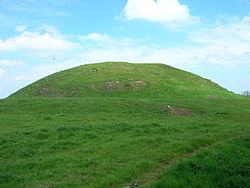Skipsea Castle
| Skipsea Castle | |
|---|---|
| Skipsea, East Riding of Yorkshire, England | |

The castle's motte
|
|
| Coordinates | 53°58′43″N 0°13′47″W / 53.978668°N 0.229589°W |
| Site information | |
| Owner | English Heritage |
| Open to the public |
Yes |
| Condition | Earthworks only remain |
| Site history | |
| Built | c. 1086 |
| Built by | Drogo de la Beuvrière |
| Events | Rebellion of William de Forz |
Skipsea Castle was a Norman motte and bailey castle near the village of Skipsea, East Riding of Yorkshire, England. Built around 1086 by Drogo de la Beuvrière, apparently on the remains of an Iron Age mound, it was designed to secure the newly conquered region, defend against any potential Danish invasion and control the trade route across the region leading to the North Sea. The motte and the bailey were separated by Skipsea Mere, an artificial lake that was linked to the sea during the medieval period via a navigable channel. The village of Skipsea grew up beside the castle church, and the fortified town of Skipsea Brough was built alongside the castle around 1160 to capitalise on the potential trade.
In 1221 the castle's owner, William de Forz, the Count of Aumale, rebelled against Henry III; the fortification was captured by royalist forces and the King ordered it to be destroyed. The remains of the castle had little value by the end of the 14th century and Skipsea Brough failed to attract many inhabitants. The castle passed into the control of the state in the early 20th century and various archaeological investigations were carried out between 1987 and 2001. In the 21st century, Skipsea Castle is managed by English Heritage and open to visitors.
The mound which Skipsea Castle was built upon was revealed in 2016 to be a much earlier Iron Age structure, of comparable construction to Silbury Hill in Wiltshire. Internal examination through drilling revealed seeds and other organic matter dating the period of construction to around 400 BC.
...
Wikipedia

